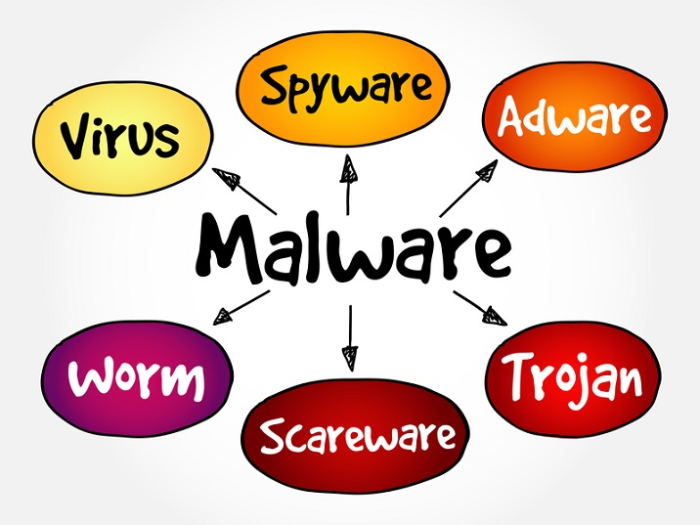
 Data Structure
Data Structure Networking
Networking RDBMS
RDBMS Operating System
Operating System Java
Java MS Excel
MS Excel iOS
iOS HTML
HTML CSS
CSS Android
Android Python
Python C Programming
C Programming C++
C++ C#
C# MongoDB
MongoDB MySQL
MySQL Javascript
Javascript PHP
PHP
- Selected Reading
- UPSC IAS Exams Notes
- Developer's Best Practices
- Questions and Answers
- Effective Resume Writing
- HR Interview Questions
- Computer Glossary
- Who is Who
Types of Malware
Malware is a term used to describe a computer program responsible for causing a disturbance in your system's working and carrying out other illicit activities. In this chapter, we would learn what the different types of malware are and how they get infiltrated into the system.
Types of Malware
Based on the infiltrating nature, attack type, and damage levels, malware are broadly classified into 12 types.
1. Viruses
The virus is the oldest Malware type and one of the most common. It is a computer program that, after infiltrating the system, replicate itself by modifying the codes of other programs. It also has the ability to reproduce in large numbers. A virus needs a host program to write its code on that program and replicate. Viruses are usually spread through a word file or executable file.
2. Worms
A worm is a malicious program that uses computer networks to spread itself. It takes advantage of the security failures of a system to target it. Once it takes control of a device, it will scan other systems connected to it and infect them. Unlike viruses, worms do not need a host to grow. The worms are largely spread through emails and message services.

3. Trojans
A trojan is a malicious program that pretends to be legitimate and attracts users to install it by misrepresenting itself as useful software for their system. It is one of the most dangerous malware since it can remain unnoticed by the user and work silently in the background. Once it gets entered into the system, the attackers behind it can gain unauthorized access to your device and steal your private information and data. The Trojan can also install other dangerous malware like Ransomware. Trojans are mainly spread through utility software, spam email attachments.
4. Spyware
Spyware is an ill-disposed, unwanted computer program that stealthily spies activities on your system and reports everything to its creator. Some Spyware can install malicious programs and change system settings. It is one of the most common malware infections since it easily enters the system when users click on an intriguing pop-up or through a bundled software.
5. Ransomware
Ransomware is one of the most dangerous malware programs. It is mainly because, unlike other common malicious programs, there is probably no cure for Ransomware attacks. After infiltrating your system, Ransomware locks your files and folders with a robust encrypting algorithm. The attacker behind it then asks you for ransom in return for a decrypting tool or key. Mostly Ransomware is spread through drive-by downloads or phishing.
6. Adware
An Adware is unwanted software designed to bombard irrelevant, untrustworthy ads on your web browser or sometimes randomly on your screen. It usually enters through malicious web extensions or rogue software.
7. Rootkit
A Rootkit is a type of malware that provides the root privilege to the attacker. A root privilege means getting the administrative rights of the system. It acts as a backdoor for other malware to enter the system. Since Rootkits resides deep inside the kernel of the operating system, it is challenging to detect and remove them. Many times, reinstalling the OS is the only option.
8. Keylogger
A keylogger is a dangerous malware that records all your keystrokes. It sends it to the attacker, who can analyze the keys you press and dig out the sensitive information such as login credentials, banking details, and literally anything private that your enter using your keyboard.
9. Browser Hijacker
Browser Hijacker, also known as Browser Virus, is a malware type that can take control of your browser and change its settings to promote an affiliated page or a fake search engine. By hijacking the browser's settings, the browser hijacker can also initiate the drive-by downloads and change settings like default search engine, homepage, new tab redirection, and more. A Browser Hijacker can also introduce other malware like Trojans, Adware, or Keyloggers to the system. Browser Hijacker usually gets entry through a rogue web extension or add-ons.
10. Botnet
A Botnet is a network of infected computers controlled remotely by a cybercriminal. Each bot acts as a Zombie and infects other systems to join it in the Botnet. Hackers can use a Botnet for carrying out various malicious activities like DDoS attacks, cryptojacking, keylogging, and more.
This is the list of 1.0 most common malware types. However, with the advancement in security the cybercriminals are finding new ways to infiltrate system, therefore every now and then a new malware type is emerging. So, malware types are not limited to just these 1.0 in the list.

